How to Create a Performance Review Process
1. Set up your goals and feedback processes
Make sure you have a robust system of aligned goal-setting and 360 degree feedback in place. This will cover your continuous performance management cycle throughout the year. You need to establish a cadence of regular check-ins on goal progress and ongoing peer feedback. Our Essential Guide to SMART Goals and Essential Guide to OKRs will take you through all you need to know to get these established.
2. Design your review format
The content of your review form(s) and how often you conduct a performance review should be decided by HR and your leadership team, taking into account recommendations from employees and managers. Whether this is quarterly, bi-annually or annually will rely on how often you’re gathering feedback and holding employee-manager check-in meetings. Use your employee engagement survey to take on board what it is your organization is really looking to track. So long as your focus is on improvement and individual development, the actual format of the review questions is entirely dependent on your company culture. We’ll go through different types of review questions you can work with below.
3. Prepare training and workshop materials
The biggest part of the review is letting your team members know why the review is being conducted and how they can get the best out of it. If employees aren’t sure what the outcome of the review is they’ll be reluctant to get on board. Managers often aren’t comfortable being the sole judge of their employees’ performance and will struggle to provide the criticism needed to improve. They also need to know what the company can offer in terms of training and career development. You can’t leave this unaddressed or your performance reviews will continue to be ineffective and you’ll undermine trust in the whole performance management process. Provide guidance for your colleagues by preparing training decks and holding internal workshops. Teach everyone the techniques to deliver honest, actionable feedback. We have some helpful guides to giving constructive feedback and encouraging feedback from employees to get you started.
4. Communicate the performance review timeline and expectations
Give a clear framework for the review timeline and the deadlines participants need to meet well ahead of the review period. Publish the review content along with your timeline so that everyone has a chance to prepare. If they’re aware of what’s involved they can properly plan their time to get the most out of the review discussion. You should make it clear to employees that they are driving the process of their self-assessment, and that it’s just as important as the manager’s assessment. Give them the tools to be autonomous and encourage their own self motivation — it’s much more powerful than being dictated to.
5. Prepare your end of review cycle communications
What are the outcomes of the review? Who will be seeing the performance appraisal? What’s expected from employees after the review is complete? Answering all of these before the review period starts is just as important as the discussions themselves. Treat your employees like the adults they are — you need to be transparent in what the performance review means and follow up on the actions you’ve promised.
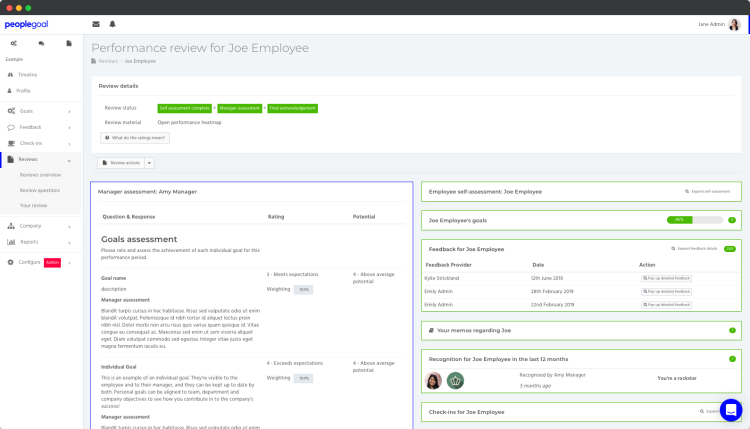
GE Performance Review: Incorporate Technology
Technology and energy company GE replaced its 30-year-old performance-review system in 2016. They implemented an app, called PD@GE, to facilitate constant, open communication between employees and managers. Teams use the app to set goals, exchange voice and text messages, send documents, and receive input from other app users within the company.
Ideas you can borrow from a GE performance review
- Keep written, regularly updated records of employee goals for employee and manager reference.
- Hold a summary conversation instead of a formal review. Have the manager and the employee work together to make a summary document.
- Implement technology that fosters open, continuous communication. For example, with Uptick team members can share priorities with managers and both parties can edit and add to the list as a result of their 1:1.

7768
Key takeaway: Don’t be afraid to change your established system. GE had the same system in place for 30 years before doing a complete overhaul.
Put Performance Requirements In Your Employee Handbook
Your employee handbook should be clear on how your performance review program works, and what is expected of each employee in regards to performance, attitude, attendance, sales, and so on.
This includes:
- What your review process is, and the timeline it occurs.
- What supervisors and managers expect of employees, and what employees should expect of them.
- What leads to an employee being fired instantly (e.g. theft), and if, in other cases, they’ll receive a written warning for their personnel file before the danger of being fired is real.
- Performance, attitude, teamwork, ethics, and any other benchmarks that you will cover in a review and that you expect employees to meet.
- What the end results of reviews might be (e.g. you won’t get fired, you might get a pay raise)
Clearly lay out your entire employee performance review program in the handbook, and go over it with each new hire.
For one thing, making this clear helps reduce fear and dread among employees. It also helps protect you legally, which is why you should work with your legal counsel when developing employee policies relating to firing.
Как оценивать сотрудников эффектно
Вот несколько советов, которые помогут оценивать сотрудников эффектно:
- Установите конкретные цели и ожидания для каждого сотрудника. Хорошая оценка производительности основывается на четких и мероприятиях метриках. Сотруднику должно быть ясно, что от него ожидается, и какие результаты требуются.
- Составьте план действий на основе полученных результатов. Оценка должна не только указывать на проблемы, но и предлагать решения. Установите цели для дальнейшего развития сотрудника и проследите за их выполнением.
- Будьте объективными и честными. Оценка производительности должна основываться на фактах и достижениях. Исключите субъективные оценки и сосредоточьтесь на конкретных результатах и статистике.
- Проводите регулярные обратные связи и разговоры. Оценка производительности должна быть не только ежегодным событием, но и непрерывным процессом. Регулярные разговоры помогают следить за прогрессом сотрудника и вносить корректировки в работу.
- Используйте 360-градусную обратную связь. Помимо оценки непосредственного руководителя, учтите мнение коллег и подчиненных сотрудника. Это позволит получить более полную картину его работы и способствовать более объективной оценке.
Следуя этим советам, вы сможете эффективно оценить производительность своих сотрудников и обеспечить их дальнейшее развитие.
Adobe Performance Review: Decentralize Timing
Software giant Adobe stopped doing annual performance reviews when they realized it was eating up thousands of hours of managers’ time. Instead, they removed stack ranking and formal skill ratings and implemented regular “check-ins.” Check-in timing is determined by department rather than by trying to line up the whole company.
Ideas you can borrow from an Adobe performance review
- Give employees a dedicated resource, especially if you’re making big changes. Adobe created an employee resource center so employees knew where to go for templates, guidelines, and other materials.
- Model change from the top. Executives all need to be on board and actively using the new system.
- Make professional growth and development a dedicated part of the conversation. Talk about how the employee can grow within the company, rather than focusing solely on past performance.

Key takeaway: Holding shorter, less formal meetings more frequently is a huge time-saver. Adobe estimates managers save over 100,000 hours a year with the new system.
Sample performance review example
Now that you understand the 15 most popular employee review templates, it’s time to craft one of your own. We created a sample performance review to give you an idea of what a general review template might look like.
Employee name: Daniela Vargas
Review period: Q4
Date of review: January 1
Employee rating: Often exceeds expectations
Strengths: Daniela had an excellent quarter. She excelled in team collaboration by stepping up to help team members brainstorm solutions in order to meet deadlines. It’s clear that Daniela really cares about her work and her teammates and embodies Apollo Enterprises’ core values.
Opportunity: While Daniela excelled in collaboration, I believe she could improve her thought leadership. There are opportunities for Daniela to learn new skills by attending workshops and keeping up with industry news which she can then bring back to the team.
Goals:
-
Learn one new industry skill a month in Q1.
-
Lead two team meetings to share thought leadership by the end of Q2.
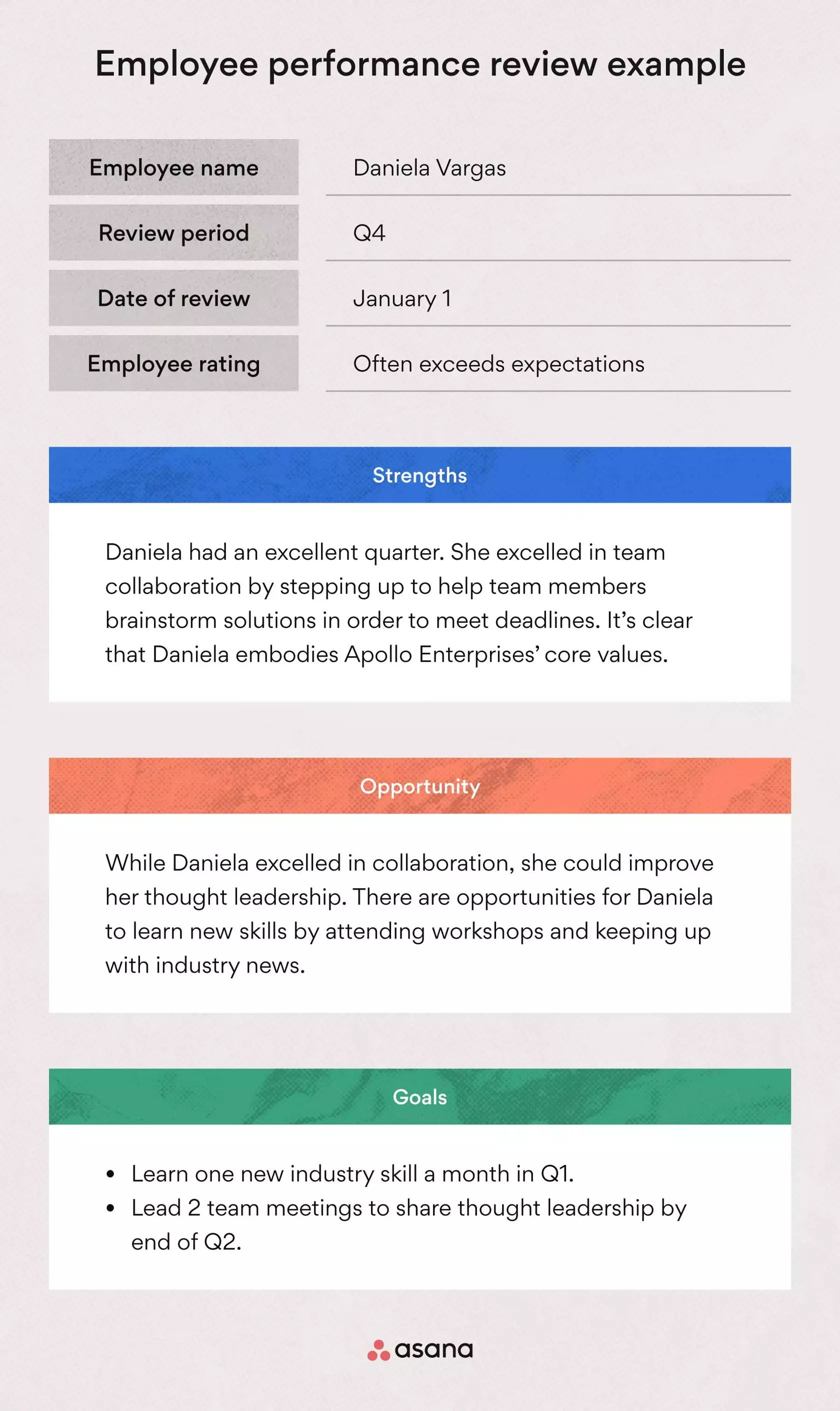
While you can use this sample as a starting point for your own effective performance review process, remember to put your own team flare into it.
Quarterly employee performance review templates
Quarterly reviews are important because they provide multiple opportunities for employees to receive helpful feedback on how to improve as the year progresses.
This quarterly performance review example reflects on specific areas of improvement, such as scaling her experiments and developing content partnerships.
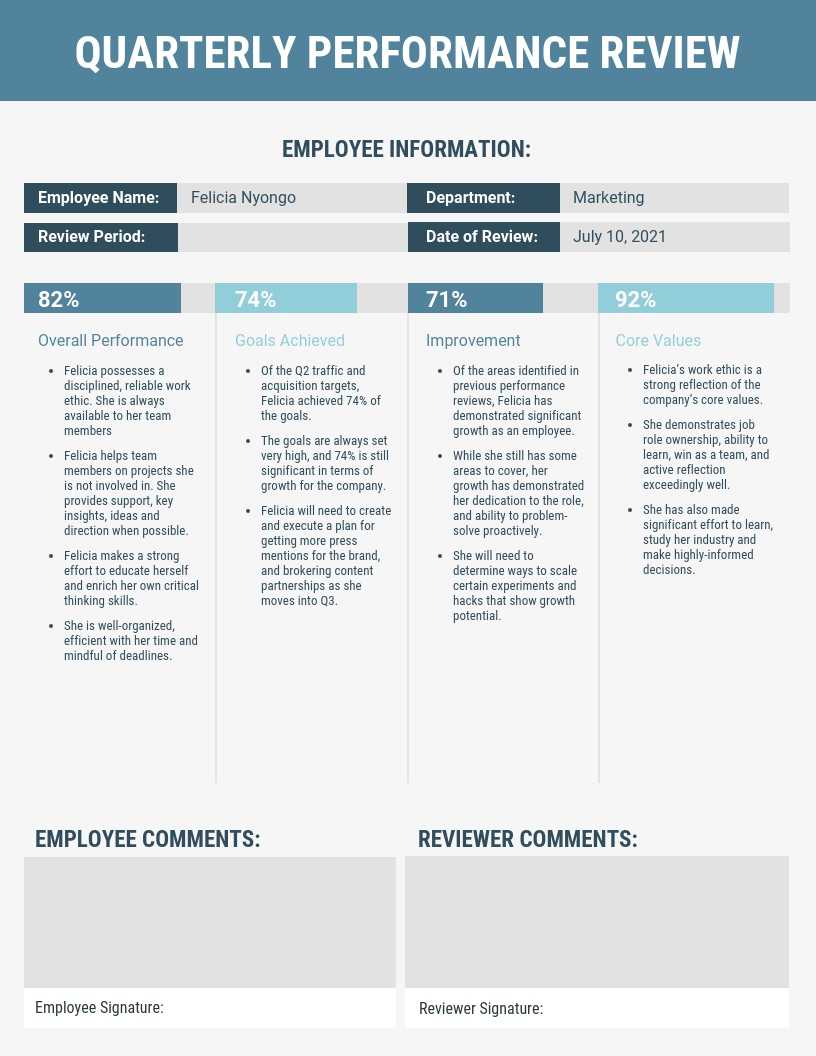
Quarterly reviews from Q1 to Q3 serve as a means of providing specific, deliberate feedback to employees so they know exactly how to improve on their goals and skills.
This enables the final, annual evaluation conducted at the end of Q4 to serve as a final assessment that will have the most weight in determining how the employee will excel into the next year, discretionary bonuses, salary increases, etc.
Quarterly reviews offer a documented and tracked record of an employee’s progress throughout the year.
This means that each quarter should be assessed using the same rubric throughout the entire year. This will aid in ensuring an accurate representation of an employee’s development is recorded.
That means, if you use the below employee review template in Q1, you should also use it again in Q2 and Q3:
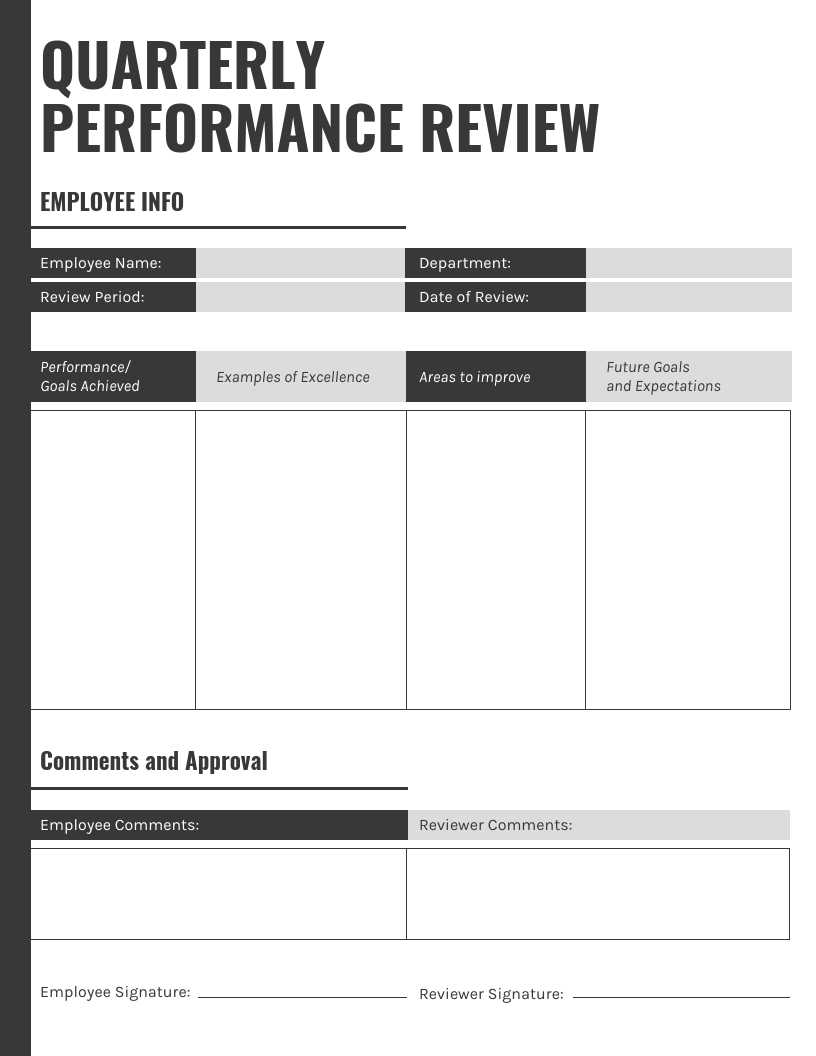
Quarterly employee review template
This quarterly review template is a more condensed version of the example above.
If you’d like to keep your quarterly reviews short and to the point, this template will suffice. Employers can then use the expanded version above for their annual review.
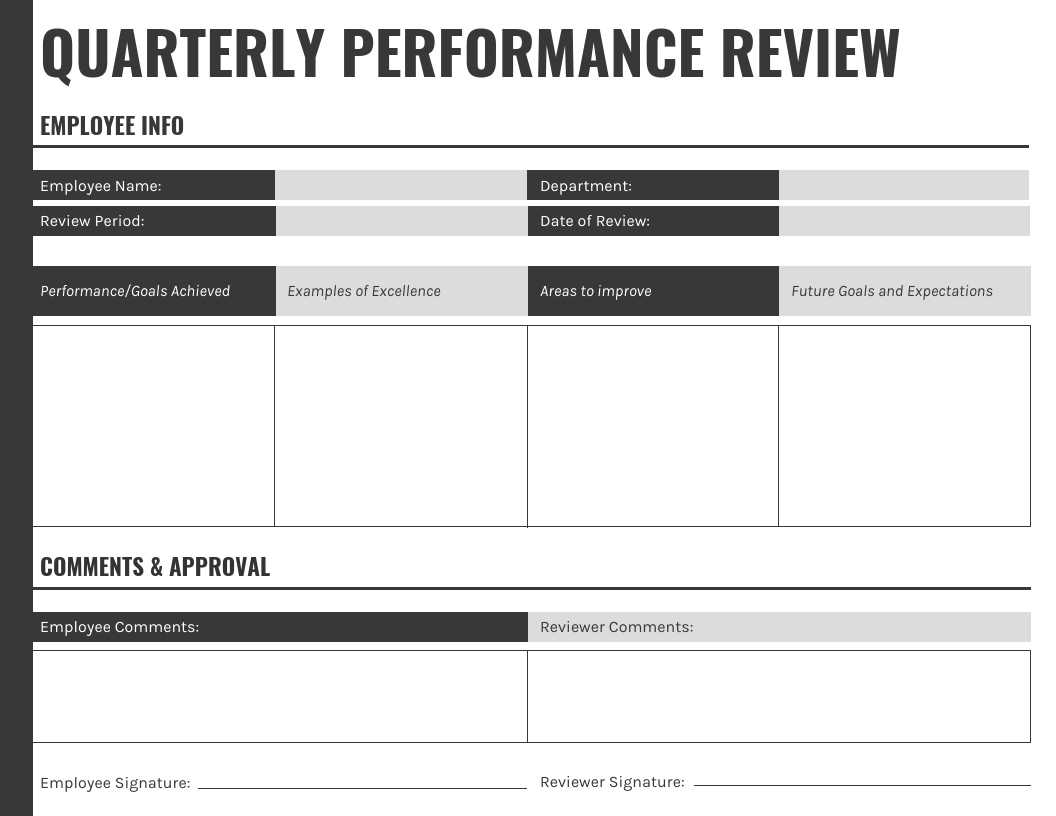
If you want a template that’s filled with useful information on the types of performance review phrases you can use for a quarterly review, you can edit the one below:
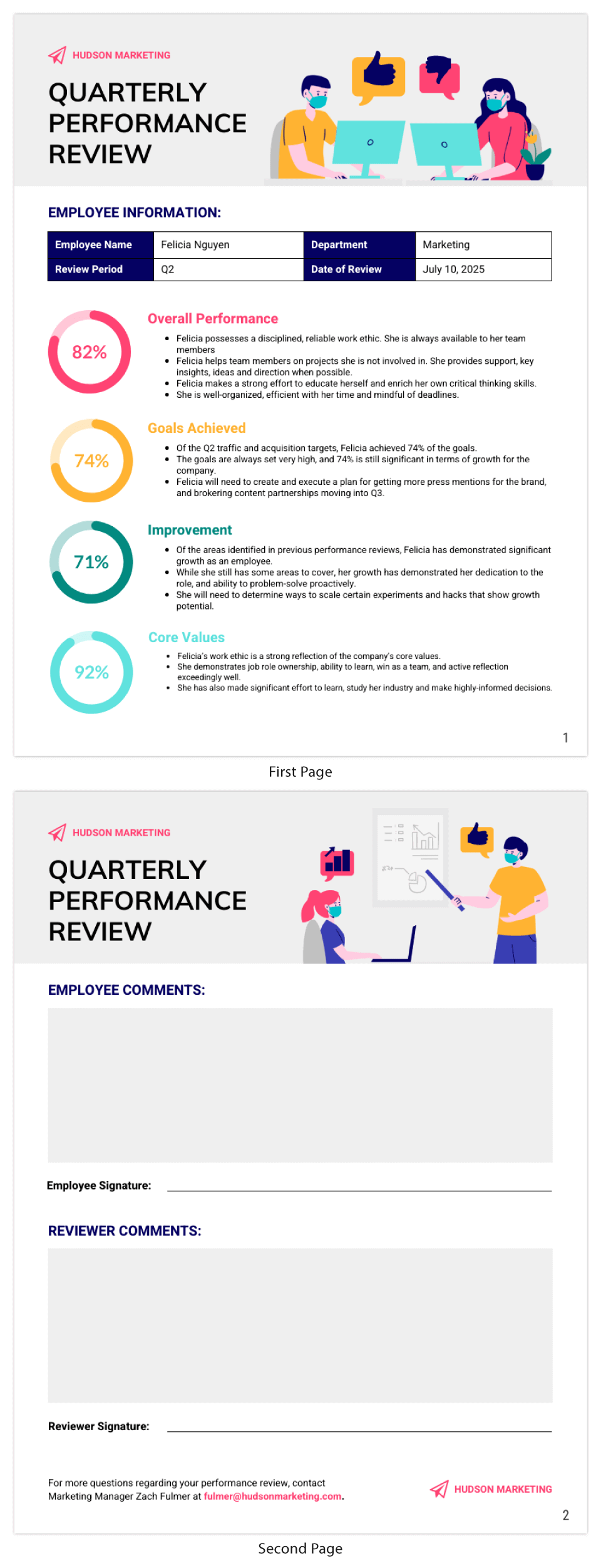
CREATE THIS REPORT TEMPLATE
Employee self-evaluation sample answers
It’s also important for employees to comment and reflect on their reviews.
They can both point out specific milestones that were missed:
- I generated five new leads and, as a result, I exceeded my sales quota by 20%
- I wrote a blog post based on original research that doubled our organic traffic in June
And also to acknowledge areas of improvement:
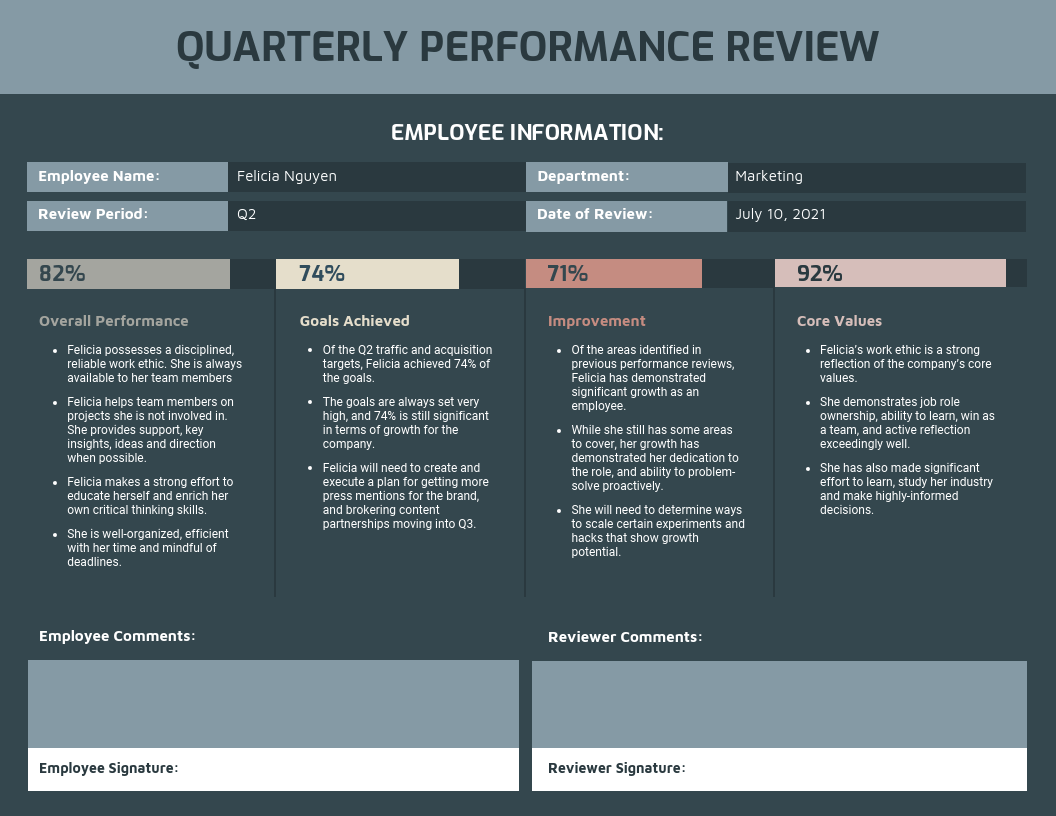
3 Types Of Reviews That Require Carefully-Crafted Questions
Companies are shifting away from traditional annual reviews to harmonious integrations of one or more progressive appraisal sessions. Each of the following types of appraisals is designed to support professional growth, increase productivity and promote better collaboration between managers and employees.
360-degree feedback
360-degree appraisal involves aggregating feedback through peers, managers, self-evaluation, and direct reports. It provides a holistic insight into the employee’s strengths and weaknesses. Employees are evaluated from different perspectives, which helps managers better measure team members’ performance competencies. Managers usually conduct the appraisal anonymously to create a safe and honest space for all participants.
Leadership review
Leadership review is a direct but anonymous feedback system for managers. This type of review is essential to help managers foster a better professional relationship with team members. Managers receive various perspectives of their professionalism and style through designated questions when collaborating with the team.
Performance review
Performance review is a high-focused appraisal program that helps employees identify potential challenges in meeting pre-determined goals. During the appraisal, employees perform self or superior evaluation in a non-judgmental environment.
Четыре этапа Perfomance Review
Процедура Perfomance Reveiw разбивается на четыре этапа (см. рис).
Рис. Четыре этапа Perfomance Review.
Этап 1. Подготовительный.
- Объявление о начале PerformanceReview. На общем собрании HR-специалист объявляет о начале Perfomance Review, напоминает цели процедуры, информирует о дате рассылки бланков-анкет и сроках их заполнения.
- Рассылка и раздача анкет. HR-специалист рассылает по электронной почте бланки-анкеты двух видов: для руководителя подразделения (он оценивает эффективность работы каждого подчиненного) и для линейного сотрудника (оценивает себя сам). Также рассылаются анкеты для оценки удовлетворенности сотрудника работой.
- Сбор анкет. HR-специалист получает заполненные анкеты, проводит предварительный анализ качества их заполнения. Если необходима коррекция или более полное заполнение, анкеты отправляются на доработку.
- Обработка и анализ. HR-специалист анализирует анкеты, отмечает разницу оценок подчиненного и руководителя. Также проводится сравнительный анализ по итоговым оценкам предыдущего Performance Review.
- Подготовка к беседе с руководителем. HR-специалист проводит подготовку к основной беседе с каждым руководителем подразделения, репетируя беседы, выделяя ключевые темы для обсуждений.
- Составление графика бесед с сотрудниками. HR-специалист составляет график с учетом пожеланий и занятости руководителей подразделений и вертикальных руководителей, проводит общее согласование, рассылает графики участникам основного этапа Perfomance Review.
Этап 2. Основной.
- Проведение беседы. На основной беседе в обязательном порядке присутствуют сотрудник, который проходит Performance Review, его непосредственный руководитель, вышестоящий руководитель и HR-специалист. В беседе может участвовать и топ-менеджер компании. На встрече анализируется работа сотрудника за прошедший период, оцениваются его результаты и достижения, проводится согласование оценок по определенным критериям, планируются профессиональные задачи и ожидаемые результаты на следующие 6 месяцев. Также ставятся задачи по развитию профессиональных и личностных компетенций, обсуждаются возможные проблемы и варианты их решений. У сотрудника есть возможность во время беседы поделиться своим мнением об эффективности бизнес-процессов в компании, о том, что его устраивает или не устраивает в работе.
- Анализ встречи. После завершения основной беседы участники встречи (без сотрудника, проходившего Performance Review) обсуждают результаты беседы.
- Принятие решений. Если по результатам собеседования необходимо провести какие-либо изменения (в оплате труда, кадровая ротация), то определяется круг лиц, принимающих такое решение, уточняются условия и время, необходимое для согласования. До формирования итогового листа HR-специалист получает результаты принятого решения.
Этап 3. Итоговый.
1. Составление итогового листа. Непосредственный руководитель составляет итоговый лист, где прописывает индивидуальный план развития (ИПР, IDP) подчиненного на следующие 6 месяцев с учетом всех предварительных договоренностей. Индивидуальный план развития сотрудника очень важный инструмент, который:
- формально закрепляет цели и задачи дальнейшего развития сотрудника;
- обеспечивает планомерное и целенаправленное развитие сотрудника;
- позволяет скоординировать рабочие цели и цели развития;
- дает возможность контроля и самоконтроля развития сотрудника;
- переводит общие идеи по саморазвитию в плоскость конкретных действий.
В итоговом листе расписаны задачи с фиксированными результатами, которых в течение последующих 6 месяцев должен достичь сотрудник. Обязательно нужно ставить цели по личностному развитию сотрудников.
2. Согласование. При необходимости итоговый план проходит согласование с вышестоящим руководителем.
3. Проведение итоговой беседы. Сотрудник, его непосредственный руководитель, а также HR-специалист на итоговой беседе подписывают итоговый лист. Один экземпляр выдается на руки сотруднику, второй остается в архиве отдела HR. Далее уже без участия руководителя HR-специалист задает ряд вопросов сотруднику, оценивая удовлетворенность сотрудника процедурой и ее результатами.
Этап 4. Сопроводительный.
Финальный этап это контроль динамики выполнения ИПР. Каждый руководитель определяет контрольные точки для фиксации или корректировки запланированных задач, промежуточной оценки успешности выполнения итогового плана, мотивации сотрудника. Сотрудники могут вносить предложения по изменению ИПР в течение всего периода до начала следующего цикла процедуры Performance Review.
Performance review examples for employees
Performance reviews for new employees are critical in setting the tone for their growth and integration into the organization.
For new employees especially, they may be nervous or unsure of what to expect for their first performance review. That’s why, it’s important for managers to create a welcoming and comfortable environment.
Start by acknowledging their achievements and progress since joining the company. Recognizing their early contributions can boost their confidence and motivation.
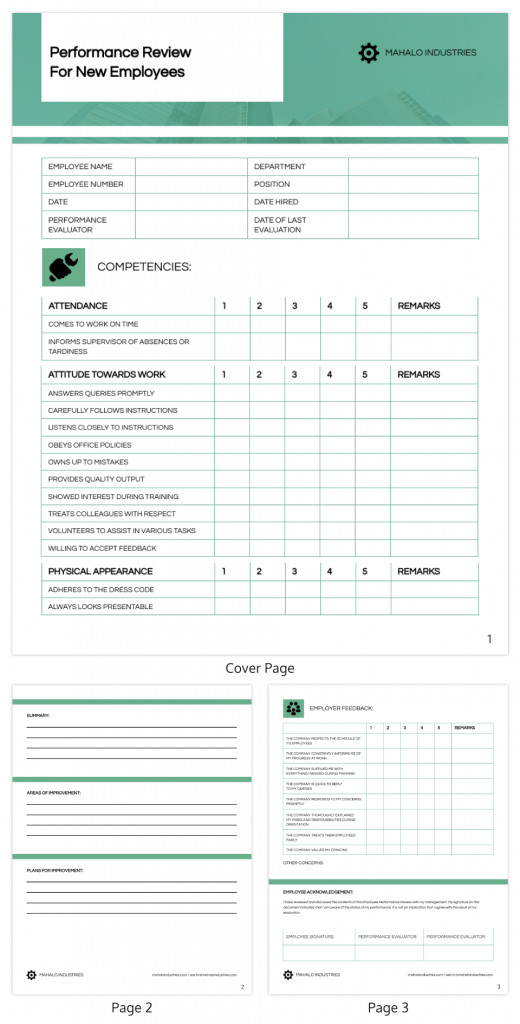
Additionally, focus on clear communication. Outline expectations and performance standards specific to their role. New employees should leave the review with a clear understanding of their job responsibilities and how their work aligns with the company’s goals.
It’s also crucial to discuss their career development. New employees often seek opportunities for advancement and growth. Use the review to explore their long-term goals within the company, and explain how their role fits into the larger career path.
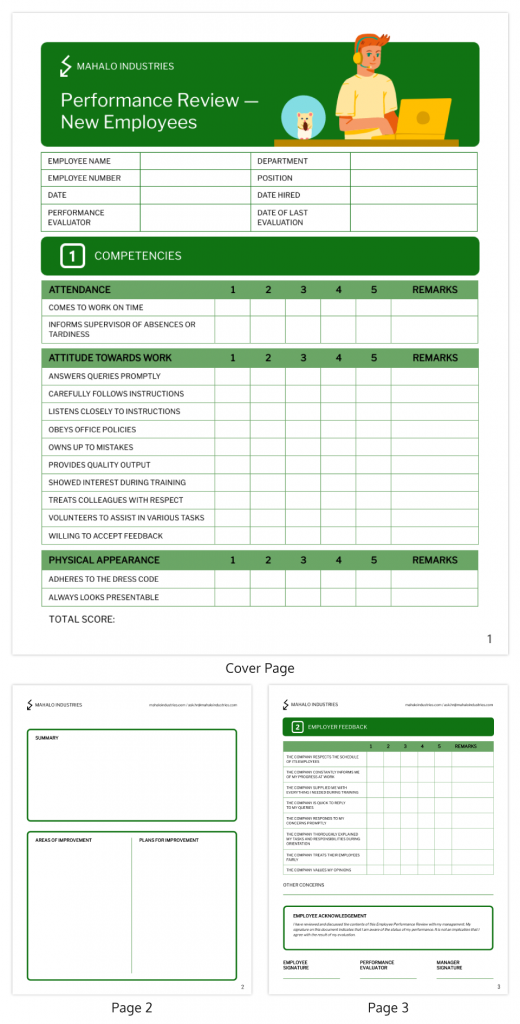
Finally, emphasize ongoing support and mentorship. New employees benefit from regular check-ins and guidance to help them acclimate and succeed in their roles.
How to give constructive feedback
Before you dive into the structure and style of various performance reviews, you must understand how to give constructive criticism effectively. Constructive criticism focuses on providing helpful feedback supported by specific examples. This gives team members the context they need to understand why they received the feedback they did.
To give effective feedback, be sure to do the following.
Notify the employee before you meet
If you don’t have a lot of experience giving feedback, it can be tempting to launch into a feedback session and get it over with as soon as possible. But in fact, the opposite is true. The more time you give your team member to prepare to receive the feedback, the more valuable the session will be. That’s because team members who are notified in advance can get into the right mindset to receive feedback openly without becoming defensive or passive.
Be sure to let the employee know about the feedback session before you sit down for the official conversation. If possible, tell the employee what the feedback will be about. For example, you might say “During our quarterly performance review next week, I’d love for you to walk through your three proudest accomplishments from the last quarter and three things you want to focus on during the next quarter. Then, I’ll share the same thing. Together, we’ll come up with next steps and focus areas for you to dive into in the coming months.” This will give them time to prepare for the meeting and prep any relevant questions on their end.
Communicate in private
It’s easy for constructive feedback to accidentally turn into a negative experience if you share it in a group setting. No matter the type or style of performance review, make sure you’re communicating feedback in a private one-on-one setting. This ensures the employee doesn’t feel targeted in a group setting.
If the type of performance review style you’re using includes feedback from more than one person—for example, peer reviews—it’s your responsibility as the team manager to aggregate that feedback and present it to your team member in private. Keeping the feedback session between you and your team member gives them a chance to process the feedback on their own time.
Offer actionable feedback
To ensure your feedback is constructive, always pair it with data-backed insights and actionable next steps. Doing so creates transparency around why the employee got a specific review based on their work. Offer specific feedback with details around what’s been working well, what they can improve, and how to get there.
For example, imagine your team member has missed some important deadlines. You want to share that feedback with them so they can prioritize hitting their due dates in the coming months. In this example, it’s significantly more valuable if you can include specific examples of due dates they missed. That way, you and your team members can refer to specific instances, work to figure out what went wrong, and then come up with concrete action items and processes they can implement in the future.
Document feedback in writing
Be sure to document constructive feedback in writing. You can do this in a feedback system or a tool like Asana. This way, you and the employee can look back on past performance and measure objectives accordingly.
This goes for positive as well as constructive feedback. Oftentimes, we overlook documenting positive feedback since, well, it’s positive. But keeping track of the team member’s major wins is a great way to increase team morale while reducing impostor syndrome and burnout.
Free performance evaluation template
How to Prepare for a Performance Review
Preparation for the Meeting
Here are a few steps that will help you prepare for the performance review meeting
-
Share the meeting agenda with the employee so that they know what will be discussed. Employees can review this agenda and add topics they want to discuss.
-
Arrange everything in advance for the meeting. The key is to make the conversation more impactful by referencing employee data.
Also, it is essential to maintain a performance record throughout the year so that you don’t base the evaluation on recent events.
Here is a list of must-haves that you should have before the start of the meeting:
-
The performance review document
-
Notes about the employee’s performance
-
360-degree feedback from the peers and supervisors
-
Customer feedback
-
Previous performance conversations
-
Responses to engagement surveys
Apart from arranging the relevant documentation, you should choose an appropriate place for the meeting as your office may not be the ideal place where you sit behind the desk.
You can schedule a time for the meeting that is most convenient for the employee. Setting aside 45 to 60 minutes for the meeting is a good idea as it gives sufficient time to discuss all the points in detail.
Steps to Conduct the Performance Review Meeting
Managers need to make the performance evaluation a smooth and comfortable experience for the employee. Here are some steps to conduct a successful performance appraisal:
Step 1: Reiterate the Goals of the Meeting
Although you may have sent the agenda beforehand, it is good to put things in perspective by mentioning the goals of the meetingand the different aspects that will be covered.
Step 2: Mention the Employee’s Achievements
One of the reasons for holding a performance review meeting is to appreciate the employee for what they have done in the past year. Be it achieving targets, developing innovative solutions, or achieving high levels of customer satisfaction, this meeting is an opportunity to recognize the positive outcomes and it also helps start the meeting on a good note.
Step 3: Define Expectations and Performance Evaluation Criteria
Let the employee know the results, actions, and behaviors that were expected from them. Also, explain the different parameters that will be used to evaluate their performance such as quality of work, productivity level, goals, and targets accomplished, and the initiatives taken by the individual.
Step 4: Review the Past but Focus on the Future
The conventional reviews had no place for future discussions and involved evaluating past performance. However, the modern process focuses on future goals and the necessary tools and guidance to achieve them. It helps in fostering a culture of growth.
So, as a leader, you should take the time to identify the gaps in skills and discuss skill development with an employee. It will help increase engagement and retention rates as more opportunities will ensure that employees do not feel stagnant in their jobs.
Rather than dwelling too much on past mistakes, this meeting should also be taken as an opportunity to identify how employees can be more valuable to the organization.
Step 5: Reiterate the Future Course of Action at the end of the Meeting
Wrap up the conversation by defining the next steps that the employee has to take. Create a plan of action so that the employee has clarity on implementing the feedback.
Подведем итоги проведения performance review в компаниях
Как мы видим из моего опыта проведения performance review, в лучшем случае, оно представляет из себя безобидный источник лулзов.
Но может быть это мне так не повезло и вообще нельзя свой личный опыт распространять на инструмент в целом?
Конечно нельзя, но, во первых, как я уже и говорил, само по себе оценивание закрытый внутри компании процесс (а когда его сделали открытым, это было эпично, вспоминаем финтех, который хотел стать брокером), поэтому за неимением более объективной информации приходится прибегать к личному опыту. А во вторых, хоть и Сергей из яндекса пытается давить своим авторитетом и заявляет, что с performance review лучше чем без него (я не сомневаюсь, Сергей, что тебе и другим руководителям стало лучше), но почему тогда так много негативных откликов о яндекс говорит нам о заниженной зарплате и о несправедливом процессе performance review?
Получается, что результат твоего performance review далек от понятий справедливости, но почему же его так любят применять компании? Теперь мы подходим к самому главному.

